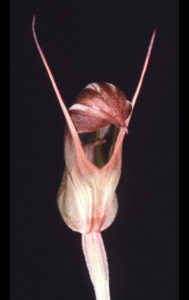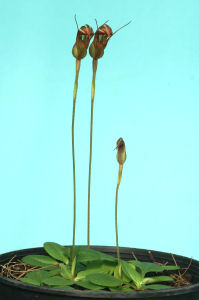The following article was written for the Orchid Species Bulletin published by the Orchid Species Society, which is based in Brisbane, Queensland in August 2009.
Bear in mind that any cultivation notes refer to the subtropical conditions of Southern Queensland, Australia.
 Taurantha collina (Rupp) M.A.Clem. & D.L.Jones is one of our Australian native terrestrial orchids that is perhaps better known as Pterostylis collina (Rupp) M.A.Clem. & D.L.Jones. Herman Rupp first described it as a variety of Ptst. ophioglossa R.Br. in the Proceedings of the Linnean Society of New South Wales in 1929. The varietal epithet was derived from the Latin collinus (growing on hills) for the habitat where it was found. Mark Clements and David Jones raised it to specific status as Ptst. collina in Australian Orchid Research Vol. 1 in 1989.
Taurantha collina (Rupp) M.A.Clem. & D.L.Jones is one of our Australian native terrestrial orchids that is perhaps better known as Pterostylis collina (Rupp) M.A.Clem. & D.L.Jones. Herman Rupp first described it as a variety of Ptst. ophioglossa R.Br. in the Proceedings of the Linnean Society of New South Wales in 1929. The varietal epithet was derived from the Latin collinus (growing on hills) for the habitat where it was found. Mark Clements and David Jones raised it to specific status as Ptst. collina in Australian Orchid Research Vol. 1 in 1989.
Based upon morphological and molecular studies, Mark Clements and David Jones transferred Ptst. collina to Taurantha D.L.Jones & M.A.Clem. in Australian Orchid Research, Vol. 4 in 2002. The generic name was derived from the Latin taurus (bull) and the Greek anther (flower) for the flower being reminiscent of a bull’s head.
Tur. collina is distinguished from Tur. ophioglossa (R.Br.) D.L.Jones & M.A.Clem. by the shiny rosette of leaves; the predominantly shiny green flowers with red-brown suffusions; and the widely divergent apical lobes of the lip.

Distributed from Gympie in southeast Queensland to Nelson Bay in New South Wales, Tur. collina grows in small colonies along the margins of rainforest and is also found in heavy forest. It is mainly a plant inhabiting wetter forest and rainforest in the ranges but can also be found on the coast.
Tur. collina is a colony-forming plant that has an underground nearly spherical fleshy tuber that is 3-7 mm in diameter. Each tuber generally produces several replacement tubers during the growing season. The tuber also produces a rosette of 5-7 broadly ovate, ground-hugging leaves that are 1.5-4 cm long and 5-20 mm broad. Bright green and shiny on the upper surface, the leaves are grey-green and shiny on the underside.
On fertile or flowering plants, the basal leaves of Tur. collina encircle an erect stem that is 10-20 cm tall. Slightly nodding, the single shiny flower is 22-28 mm long and 9-12 mm across. The flower is green with white stripes on the galea (hood formed by the dorsal sepal united with the petals), and is heavily suffused and striped with red-brown. The notched dark red-brown lip protrudes prominently from the opening when in the set position. Lacking any of the red-brown colouration, Tur. collina f. virida has green flowers that are striped with white and a green lip.
David Jones (1998) recommends a potting mix based upon sandy loam mixed with about one third leaf mould or eucalyptus shavings. The Australasian Native Orchid Society, Victorian Group’s (1988) basic mix consists of 2 parts coarse sand, 1 part rich loam, 1 part buzzer chips (wood chips/shavings), 1 part leaf mould. To each 9 litre bucket of the basic mix is added 1 dessertspoonful of blood and bone and 1 dessertspoonful of garden lime or dolomite. During active growth from autumn to spring Tur. collina can be watered regularly to keep the mix evenly moist. An occasional application of dilute fertiliser solution can be given. Alternatively a small amount of organic fertiliser such as blood and bone can be added to the potting medium. After the plants die down and become dormant for the summer period the potting mix should be allowed to dry so that the tubers do not rot.
Annual repotting is recommended in late summer (December & January) to ensure that the plants do not become too crowded and to also renew the potting medium. Many growers like to combine some of the old media with new mix. If you are re-using some of the old media ensure that the same tubers are replanted into the same mix, in order to prevent spread of virus. The repotting stage is also a good time to sort the tubers into various sizes and separate out the larger, flowering size plants from the smaller, rosette producing plants.
Cultivation of Australian Native Orchids is published by the Australasian Native Orchid Society, Victorian Group. I recommend it is an excellent publication for information on the culture of Pterostylis and other Australian terrestrial orchids.
